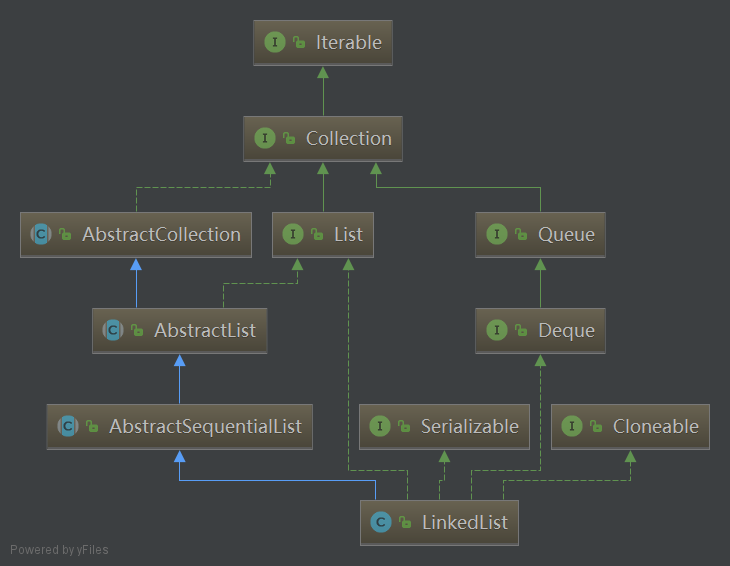brief introduction
LinkedList is a two-way linear linked list, but it does not store data in a linear order, but a pointer (Pointer) to the next node in each node. Since it is not necessary to store in sequence, the linked list can achieve O(1) complexity when inserted, which is much faster than another linear table sequence table, but it takes O(n) time to find a node or access a specific number of nodes, and the corresponding time complexity of the sequence table is O(logn) and O(1), respectively.

UML Diagram

Use examples
LinkedList list = new LinkedList<>(); //Newly added list.add("a"); list.add("a"); list.add("b"); System.out.println(list); //delete list.remove("a");//Delete the first corresponding object list.remove(0);//Delete elements marked 0 list.removeFirst();//Delete the first element list.removeLast();//Delete the last element System.out.println(list); //modify list.set(0,"c");//Modify elements with subscripts of 0 System.out.println(list); //insert list.add(1,"a");//Can only be inserted in front, back or middle of an existing element System.out.println(list); //Obtain list.get(0);//Obtain elements based on Subscripts list.getFirst();//Get the first element list.getLast();//Get the last element //loop //Ordinary cycle for(int i=0;i<list.size();i++){ System.out.println(list.get(i)); } //foreach loop for(Object o:list){ System.out.println(o); } //Iterative cycle Iterator iterator = list.iterator(); while (iterator.hasNext()){ System.out.println(iterator.next()); }
Source code parsing
Initialization
node
//The Core Class of Linked List-Node private static class Node<E> { //Node element E item; //Next Node Reference Node<E> next; //Last Node Reference Node<E> prev; Node(Node<E> prev, E element, Node<E> next) { this.item = element; this.next = next; this.prev = prev; } }
Construction method
//Default size transient int size = 0; //First node transient Node<E> first; //Last node transient Node<E> last; //Parametric structure public LinkedList() { } //Constructions with Initialized Sets public LinkedList(Collection<? extends E> c) { this(); addAll(c); }
Analysis of addAll
public boolean addAll(int index, Collection<? extends E> c) { //Detect whether the boundary is crossed //Initialization does not cross the bounds. It is mainly used to increase the number of collections after initialization while modifying the collections at the same time, the cross-bounds exception will occur. checkPositionIndex(index); Object[] a = c.toArray(); //Judging whether a set is empty int numNew = a.length; if (numNew == 0) return false; // Node<E> pred, succ; //If index==size, the list has only one node if (index == size) { succ = null; pred = last; } else { succ = node(index); pred = succ.prev; } //Loop collections into linked lists for (Object o : a) { @SuppressWarnings("unchecked") E e = (E) o; Node<E> newNode = new Node<>(pred, e, null); if (pred == null) first = newNode; else pred.next = newNode; pred = newNode; } //last is the same as the current node when it is a node if (succ == null) { last = pred; } else { pred.next = succ; succ.prev = pred; } //Update the length of the linked list size += numNew; modCount++; return true; }
Analysis of Common Functions
increase
//Increase the element by default to add nodes to the end of the list public boolean add(E e) { linkLast(e); return true; } void linkLast(E e) { //Get the end node of the list final Node<E> l = last; //Create a new node, refer to the last node as the previous node of the new node, and the element as the incoming element final Node<E> newNode = new Node<>(l, e, null); //The end of the list points to the latest node last = newNode; //If the original tail node is empty, it means that the header node of the list needs to be set for the empty list. //Otherwise, the next of the end node of the original list is pointed to the new node. if (l == null) first = newNode; else l.next = newNode; //Increase size size++; //Recording the number of modifications, mainly for set iteration, to ensure the accuracy of iteration data //If the set changes during iteration, an exception is thrown //throw new ConcurrentModificationException(); modCount++; }
delete
//Delete nodes according to Subscripts public E remove(int index) { //Detecting whether subscripts are out of bounds checkElementIndex(index); return unlink(node(index)); } //Get the node of index Node<E> node(int index) { //If the subscript is less than half the length of the list, look ahead //Otherwise, look forward from behind the list if (index < (size >> 1)) { //The query method assigns values one by one from the table header until the subscript position is specified. Node<E> x = first; for (int i = 0; i < index; i++) x = x.next; return x; } else { Node<E> x = last; for (int i = size - 1; i > index; i--) x = x.prev; return x; } } //Delete the first node public E removeFirst() { final Node<E> f = first; if (f == null) throw new NoSuchElementException(); return unlinkFirst(f); } //Disconnect the first node private E unlinkFirst(Node<E> f) { final E element = f.item; final Node<E> next = f.next; f.item = null; f.next = null; // help GC //Set the next node of the current node as the first node first = next; if (next == null) last = null; else next.prev = null; size--; modCount++; return element; } //Delete the last node public E removeLast() { final Node<E> l = last; if (l == null) throw new NoSuchElementException(); return unlinkLast(l); } //Disconnect the last node private E unlinkLast(Node<E> l) { final E element = l.item; final Node<E> prev = l.prev; l.item = null; l.prev = null; // help GC //Set the last node to the previous node of the current node last = prev; if (prev == null) first = null; else prev.next = null; size--; modCount++; return element; }
Modify (replace) elements
//Modify an element public E set(int index, E element) { //Detecting whether subscripts are out of bounds checkElementIndex(index); //Obtain nodes based on Subscripts Node<E> x = node(index); //Get the element of the node E oldVal = x.item; //Assign new elements x.item = element; return oldVal; }
Insert elements
//Insert the specified location element public void add(int index, E element) { //Detecting whether subscripts are out of bounds checkPositionIndex(index); //Determine if the subscript is the last position and if it is inserted directly into the last node //Otherwise, the current index node is queried and the new node is placed before the original index node. if (index == size) linkLast(element); else linkBefore(element, node(index)); } //Location before inserting index node void linkBefore(E e, Node<E> succ) { final Node<E> pred = succ.prev; final Node<E> newNode = new Node<>(pred, e, succ); succ.prev = newNode; if (pred == null) first = newNode; else pred.next = newNode; size++; modCount++; }
Get elements
//Obtain elements based on Subscripts public E get(int index) { //Detecting whether subscripts are out of bounds checkElementIndex(index); //Get the node according to the subscript, and then return the element of the node return node(index).item; } //Get the first element public E getFirst() { final Node<E> f = first; if (f == null) throw new NoSuchElementException(); return f.item; } //Get the last element public E getLast() { final Node<E> l = last; if (l == null) throw new NoSuchElementException(); return l.item; }
Clear all data
public void clear() { // Clearing all of the links between nodes is "unnecessary", but: // - helps a generational GC if the discarded nodes inhabit // more than one generation // - is sure to free memory even if there is a reachable Iterator //Assign all data to null one by one to help gc recycle garbage for (Node<E> x = first; x != null; ) { Node<E> next = x.next; x.item = null; x.next = null; x.prev = null; x = next; } first = last = null; size = 0; //Record clearance operations to ensure the accuracy of iterations modCount++; }
summary
- Advantage
1. Efficient insertion and removal of data 2. Easy use of linked lists as stack or queue scenarios 3. linkedlist does not need to be expanded relative to arraylist - shortcoming
1. It is inefficient to acquire elements according to randomness (acquired by subscripts)
2. Low efficiency of batch adding collections
Other
In arraylist and linkedlist, there is a modifier transient. The attributes of this modifier can not be serialized by default. In order to reduce the waste of space, the jdk author implements two methods: write Object (Object Output Stream) and read Object (Object Input Stream). Manual serialization has useful attributes for storing data.
Reference resources

Please pay more attention to Wechat...